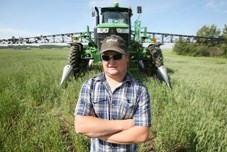Farmers in the “hail capital of Canada” are able to access increased insurance coverage for crops destroyed by major storms.
Alberta’s Agriculture Financial Services Corporation (AFSC) has increased hail coverage following three years of record hail damage in the province.
The agency is increasing coverage this year by a minimum of $75 to $225 per acres on dryland crops and $175 to $400 per acre on irrigated crops. Coverage for specialty crops is rising by $75 to $525 per acre on dryland crops and $275 to $950 on irrigated crops.
The agency has also created special categories for high-value crops like chickpeas and canola, which can be insured for $325 per dryland acres and $425 for irrigated crops.
Jackie Sanden, AFSC area program coordinator, is a result of rising production costs and requests from clients.
As well, she said creating specific categories for canola and chickpeas provides more coverage for farmers growing those crops as they had previously been covered as a major crop.
“The coverage levels this year are significantly higher because those crops are priced quite a bit higher in the commodity markets,” said Sanden.
She said premium rates vary by township and can vary depending on losses in previous years.
“Some of them have seen an increase and some have seen decreases,” said Sanden. “Overall provincially, I’d say on average there has been an increase because we’ve had some major incidents that have been high dollar, and of course that will increase premiums.”
Last year saw the third highest amount of hail damage to crops in the 77 years AFSC has served as a hail insurer.
The agency’s branches reported 522 storm cells last year from the U.S. border to Fort Vermillion in northern Alberta. More than $257 million was paid out on more than 6,400 hail claims across Alberta last year.
The AFSC marked a record two years ago in 2012, which saw $445.6 million paid out on more than 8,400 claims.
Sanden said it’s too early to know what to expect this year.
As of July 7, AFSC had received 547 claims. By July 10, there were more than 1,100 claims.
“In the Olds, Three Hills, Airdrie, Strathmore area there was a lot of storm activity on [July 6],” she said. “That has definitely resulted in claims being entered over the last couple of days… just like that we’ve doubled.”
The increased hail coverage is good news to one Okotoks-area farmer.
“With the price of seed and fertilizer and everything else we use these days, obviously the increase will help us watch our bottom line,” said Mike Imler.
So far this year, he said he hasn’t seen any hail damage so far this year.
He said he uses AFSC for insurance and he has seen more hail damage in the past three years.
“It seems like in the past three years, for sure, we’ve always had a claim on something, because we have some area that gets hit,” said Imler.
A senior climatologist with Environment Canada said it’s difficult to say whether hailstorms are becoming more prevalent, but Alberta is Canada’s hail capital.
“I can’t tell you whether this is going to be a rip-roaring year with regards to an crop insurance agent’s nightmare… in terms of being pounded with basketball sized hail,” said David Phillips, Environment Canada senior climatologist. “All I can tell you is this, it’s very much part of your climate.”
He said Alberta’s altitude contributes to the number of hailstorms it gets.
“If you get a very warm day in Okotoks, the temperature could be 28 C degrees on the surface, but because you’re so elevated you wouldn’t have to go too high up in the atmosphere to find some very cold temperatures… because you’re higher up you’re closer to that freezing level,” he said.




